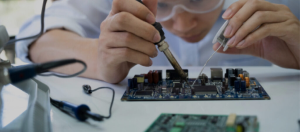Industrial Design for MedTech Product Development
The Role of Industrial Design in MedTech
Challenges in Industrial Design for MedTech
Designing for the MedTech industry comes with a unique set of challenges that require specialized knowledge and a deep understanding of both the medical and design fields. At TechFlex, our experience in overcoming these challenges positions us as leaders in the field of industrial design for medical devices.
One of the most critical aspects of industrial design in MedTech is ensuring that the device is ergonomically sound and user-friendly. Medical devices are often used in high-pressure situations where ease of use is paramount. TechFlex designers prioritize ergonomic principles, creating designs that reduce user fatigue and increase efficiency. Whether it’s a handheld surgical instrument or a large diagnostic machine, our designs ensure that the device can be operated comfortably and intuitively.
While functionality is the core of any medical device, aesthetics also play a significant role, especially in consumer-facing medical products. A well-designed device not only enhances the user experience but also strengthens brand identity and market presence. Our designers work to create products that are not only functional but also aesthetically aligned with your brand’s identity, making your product instantly recognizable and appealing.
Medical devices must be constructed from materials that are durable, biocompatible, and capable of withstanding frequent cleaning and sterilization. The choice of materials impacts not only the device’s durability but also its weight, cost, and manufacturability. TechFlex’s industrial designers collaborate with material scientists and engineers to select the best materials for each application, ensuring that the final product is both durable and cost-effective. We also consider factors such as surface finish and texture, which can impact both usability and aesthetics.
Compliance with regulatory standards is a non-negotiable aspect of MedTech product development. Industrial design plays a critical role in ensuring that devices meet FDA human factors requirements. Our team at TechFlex is well-versed in the regulatory standards that govern medical device design, including ISO and FDA guidance. We incorporate these requirements into the design process from the outset, ensuring that the final product is safe, effective, and ready for the regulatory approval process.
Sustainability is becoming increasingly important in the design and development of medical devices. TechFlex is committed to incorporating environmentally friendly practices into our industrial design processes. This includes selecting recyclable materials, designing for disassembly, and reducing the overall environmental impact of the product lifecycle. We work with our clients to create sustainable designs that meet both their functional needs and their environmental goals.
Understanding the context in which a medical device will be used is essential to successful design. TechFlex designers immerse themselves in the clinical environment to gain insights into how devices are used in real-world settings. This includes understanding the workflows of healthcare professionals, the physical and psychological needs of patients, and the challenges posed by different clinical environments. By integrating this understanding into our design process, we ensure that our products are not only functional but also fit seamlessly into the clinical workflow.
TechFlex’s Industrial Design Capabilities
Concept Development and Ideation
After we understand the user needs and requirements, The next step in our industrial design process is developing a strong concept. Our designers engage in brainstorming and ideation sessions to explore a wide range of design possibilities. We use sketching, 3D modeling, and prototyping to visualize these ideas and refine them into a coherent design direction that meets the project’s functional and aesthetic goals.
3D Modeling and CAD Design
Once a concept is developed, we move into detailed 3D modeling using advanced CAD (Computer-Aided Design) software. This allows us to create precise digital models of the product, complete with all components and assemblies. These models serve as the foundation for both virtual simulations and physical prototyping, enabling us to test and refine the design before moving into design integration.
Rapid Prototyping
Prototyping is a critical step in the industrial design process. At TechFlex, we use rapid prototyping techniques to create physical models of the product that can be tested and evaluated. This allows us to identify any design issues early in the process and make necessary adjustments. Our prototyping capabilities include 3D printing, CNC machining, casting, and injection molding, allowing us to create prototypes that closely mimic the final product.
Human-Centered Design
At the heart of our design philosophy is human-centered design. We place the user at the center of our design process, ensuring that every product we develop is intuitive, comfortable, and easy to use. We conduct user testing and gather feedback throughout the design process, iterating on the design to improve usability and user satisfaction.
Design for Manufacturability (DFM)
Ensuring that a design can be efficiently and cost-effectively manufactured is a key consideration in our industrial design process. Our designers work closely with engineers and manufacturing partners to optimize designs for manufacturability. This includes considering factors such as material selection, subsystem design, Poke Yoke methods and other production methods, and assembly processes to ensure that the product can be produced at scale without compromising on quality.
Visual and Brand Design
In addition to functional design, we focus on the visual and brand aspects of the product. Our designers create products that are visually appealing and aligned with your brand’s identity. This includes selecting colors, finishes, and textures that enhance the product’s appearance and ensure that it stands out in the marketplace.
Ergonomics and Usability Testing
Ergonomics is a critical consideration in the design of medical devices. We conduct extensive usability testing to ensure that our designs are comfortable and easy to use. This includes evaluating the product’s weight, balance, and grip, as well as ensuring that it can be operated intuitively by users of all skill levels.
Why Partner with us for MedTech Industrial Design



